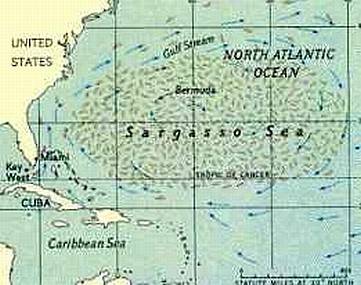| "A lot of plants get caught in the Gulf Stream
and are swirled into the central North Atlantic Gyre, where they
accumulate in the quiet center of the current system that circles
that part of the globe. This is the place known as the Sargasso Sea.
It is a region of little rain and wind, a high-evaporation rate, and
very clear, salty water, which stands at a higher level than that of
the surrounding ocean." "It is estimated that some ten million tons of sargassum float in that tranquil sea. The weed accumulates there, partly because more of it drifts in on the Gulf Stream than drifts out the other side on the Equatorial Current, and partly by vegetative reproduction. Algae were pioneers in the art of sexual reproduction. The sargassum algae, however, are for some reason unable to procreate sexually. 'They simply grow and reproduce by breaking off branches of themselves. The individual plants probably never die, unless they are smashed by waves. Rachel Carson suggested that some of the Sargasso weeds out there in the Sargasso Sea today might have been seen by Columbus. In his time the place was feared by mariners as a trap for ships."
|
